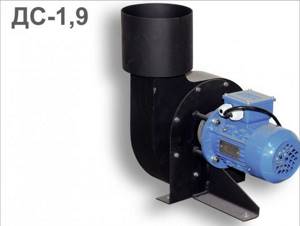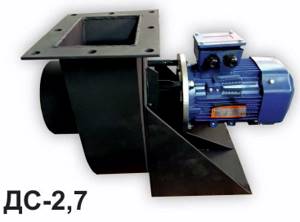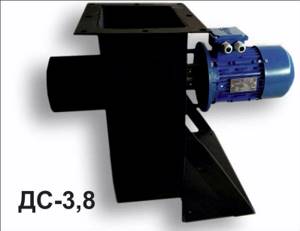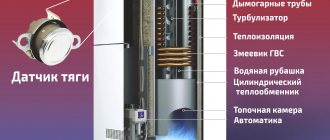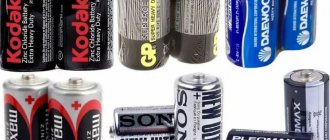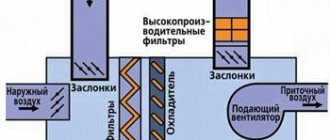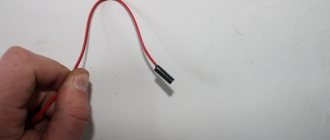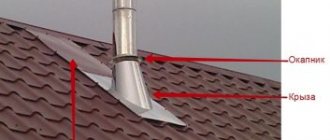Home / Solid fuel boilers
Back
Published: 02/27/2020
Reading time: 5 min
0
4404
Installation of a blower fan on a solid fuel boiler is carried out to optimize combustion processes, which leads to an increase in the efficiency of the thermal circuit and fuel economy.
A fan for a solid fuel boiler can be made independently, which will allow the owner to save significant funds on purchasing a factory-made analogue.
- 1 Purpose of a fan for a boiler
- 2 Design and principle of operation
- 3 Varieties 3.1 Electrically commutated motor
- 3.2 Synchronous motor
- 3.3 Blowers with asynchronous motor
Why do you need a smoke exhauster?
- automate the boiler operation process by turning off the smoke exhauster when the set temperature is reached and turning it on when the temperature drops below the established norm, which eliminates constant human supervision of the boiler;
- eliminate black smoke from the chimney, as well as soot and soot because a smoke exhauster, like a forge in a forge, sharply increases the amount of oxygen in the firebox, which ensures complete combustion of coal;
- increase the boiler power and increase the boiler efficiency;
- prevent smoke from entering the room, because it creates a vacuum in the boiler, so it does not smoke. To avoid smoke when loading coal, you must turn on the smoke exhauster;
- allow the stove to fire in any weather, even when there is no draft, because they force air into the boiler;
- used to replace blower fans in order to eliminate smoke in the boiler room and increase its efficiency;
- if a smoke exhauster is used that creates a high air flow rate (especially at 3000 rpm), then this contributes to the self-cleaning of the heat exchanger - the abrasive effect of smoke with small particles.
After installing a smoke exhauster, the temperature in the boiler furnace rises sharply due to the supply of a sufficient amount of air for complete combustion of the fuel (including tar and soot), black smoke disappears from the chimney, and cleaning of both the boiler itself and the chimneys is required much less frequently.
VDN fan and VD fan
A blower fan VDN or VD is used to pump air into the furnaces of boiler units and create the necessary draft in boiler houses, thermal power plants and others. Blower fans (draft fans) VDN are sometimes called smoke exhaust fans. In principle, blower fans are practically no different from smoke exhausters, except for the purpose and thickness of the body metal (for smoke exhausters it is larger), because smoke exhausters work with high temperatures of the working environment, sucking hot gases from the boiler furnace. As a standard, the smoke exhauster DN and the blowing machine VDN work in pairs, providing draft and the necessary performance of the boiler equipment. We have many VDN blowing machines in stock, but blowing machines larger than VDN12.5 are supplied only to order; according to the third or fifth scheme, they are also made only to order. This is due to the fact that the number of possible versions of any such blowing machine is huge, and one cannot be replaced by another, since installation will be impossible (if the angle of rotation of the volute, the assembly diagram, the direction of rotation of the impeller does not converge) or the operating parameters will not be provided ( if the power of the electric motor does not match), therefore only the most common and universal units are always available. It is imperative to take into account when planning a boiler room repair: the delivery time for a VDN blower fan can, depending on its size and drive electric motor, be quite significant (especially for large machines that use high-voltage DAZO electric motors as a drive)!
Our website provides information about VDN and VD blower fans. Of course, the question arises: what is the difference between a VDN and a VD fan? There is no difference between the VDN and VD fans in terms of purpose, mounting options, operating principles, or ordering information; it is only in the operating parameters and design features. The fans VDN 18, VDN20 and VDN 22 have twelve profiled backward-curved blades in the impeller. VDN 18, VDN20 and VDN 22 are low pressure machines. Blowing machines VDN 6.3, VDN 8, VDN 9, VDN 10, VDN 11.2, VDN12.5, VDN 13, VDN 15, VDN 17, VDN 19, VDN 21 have sixteen backward-curved blades in the impeller. These are medium and high pressure machines. VD 2.5, VD 2.7, VD 3.5, VD 13.5, VD 15.5, VD 18 and VD 20 have thirty-two forward curved blades in the impeller. These are medium and high pressure machines. In principle, when selecting a blower fan, you can not pay attention to the letters in the designation; it is important, first of all, that the operating parameters and dimensions of the machine are suitable.
Source
What power is the smoke exhauster needed?
This depends on the power of the heating boiler in which it is installed:
- DS-1.9-170-220 for boilers with power up to 40 kW;
- DS-2.2-370-380 for boilers with power up to 80 kW;
- DS-2.7-750-380 for boilers with power up to 180 kW;
- DS-3.8-1500-380 for boilers with power up to 300 kW
When smoke exhausters are connected in parallel to the chimney, two DS-3.8-1500-380 are suitable for a boiler with a power of up to 600 kW, and two DS-2.2-370-380 are suitable for a boiler with a power of up to 160 kW.
How does a smoke exhauster work?
The smoke exhauster, drawing flue gases from the boiler, creates a vacuum in it and thus air enters the furnace through the grate for burning coal or other solid fuel. This prevents the flow of smoke from loosely closed firebox doors when the seals wear out.
A powerful air flow quickly ignites the boiler and the required coolant temperature is reached, after which the smoke exhauster turns off. If the boiler has a smoke exhauster, the length of the pipe does not affect the draft.
When the smoke exhauster turns off, coal combustion will slow down and the temperature of the coolant will begin to drop. The smoke exhauster will turn on again when the coolant temperature drops below the set value and the process will repeat again.
Design and principle of operation
Regardless of the manufacturer, the fan consists of an aluminum or galvanized housing, inside of which there is an electric motor, guide blades and protection in the form of a lattice fence.
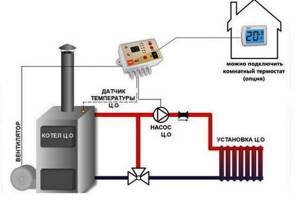
This design, despite its simplicity and small dimensions, is reliable. A damper is installed on the supercharger, which is designed to limit the penetration of flue gases into the combustion room in the event of reverse draft.
Also, the damper reduces natural draft when there is no air supply.
The connecting pipes can be located in the upper part of the housing or on the front part of the blowing unit and have various forms of connectors for connection to the boiler. Algorithm for the functioning of the boiler control system using blown air:
- the heating device is filled with solid fuel and ignited;
- the blower is turned on and the air flow is regulated;
- when air is supplied to the combustion zone, intense combustion of the fuel begins, and therefore the temperature of the coolant begins to rise;
- when the temperature reaches the set value, the control unit controller gives a signal to turn off the supercharger;
- air deficiency will lead to a decrease in the intensity of fuel combustion and a decrease in coolant temperature.
How to install a smoke exhauster?
Where should I install it?
According to the project. If it is not there, then it is recommended to install a smoke exhauster in the boiler room in close proximity to the boiler. It is not recommended to install a smoke exhauster outdoors, because... precipitation can lead to corrosion of the smoke exhauster because Flue gases contain sulfur oxide and nitrogen oxide, which leads to the formation of nitric and sulfuric acid when condensation is formed from atmospheric air.

Install the smoke exhauster according to the figure at points 7-10. The outlet pipe can be rotated in 45° increments and is connected to the chimney pipe tee on the side so that soot and condensate from the pipe do not enter the smoke exhauster, but flow through the condensate drain.
Design features of the VDN fan
The design is similar to other centrifugal fans. Main parts:
- Spiral-shaped steel housing with a horizontal connector and an access hatch to the fan impeller. Stiffening ribs made from channels reinforce the metal of the “snail”.
- A fan wheel consisting of a hub and an impeller with 16 backward-curved blades.
- Suction funnel.
- Axial guide device.
- Installation frame.
Fans with backward-curved blades are less noisy, they have a wider range of air flow, and there are no zones of unstable operation. Their efficiency coefficient is the highest among all centrifugal fans. The price for these advantages is an increase in weight and size (compared to equipment with forward-curved blades), as well as the inability to operate in “dirty” rooms (where there are a lot of impurities and dust in the air). With this design of the impeller, dust particles settle on it, causing imbalance and vibration.
The VDN fan can be manufactured with the housing position LO or PO, which means the direction of rotation of the impeller - left or right. To determine the type of rotation, you need to look at the wheel from the electric motor side. When rotated to the right, it moves clockwise. On the left - counterclockwise.

VDN-10 fans are produced in three versions:
- Execution 1. The fan wheel is mounted on the electric motor shaft.
- Version 3. The fan wheel is connected to the engine through a bearing unit.
- Execution 5. The fan wheel is installed on the shaft of the bearing assembly, which is connected to the electric motor using a V-belt drive.
How to regulate the coolant temperature with a smoke exhauster?
How often should it be turned on? Can a fireman do this manually?
The operating mode of the smoke exhauster depends on the boiler power and the ambient temperature in winter. The operating time can be 5-10 minutes and it will not work for several minutes while the temperature drops.
This can be done manually by a person, but the use of a thermostat allows you to fully automate the maintenance of the temperature of the coolant leaving the boiler set by the operator.
Boiler automation produced by BAGAN
How to connect it to the mains voltage.
The smoke exhauster is connected through a thermostat, which controls the temperature of the coolant leaving the boiler and periodically turns on the smoke exhauster when the coolant temperature drops, and then turns it off when the set temperature is reached.
The smoke exhauster can be connected through the standard boiler control unit when replacing the blower fan with a smoke exhauster, if their powers are the same.
If the power of the smoke exhauster is greater, then the electrician must connect it through a contactor of the appropriate power. If such a unit is not available, you must purchase a device that is available from our company.
Connecting the electric motor.
The power cable must be connected using cable lugs only. Use cable lugs of the appropriate cross-section to prevent overheating of the cable connection to the winding terminals. The cable to the terminal box must be connected without tension, and the contact connections must be securely tightened.
Motor protection.
Each electric motor must be protected against overload and short circuit. The settings of the protection devices must correspond to the operating mode of the electric motor, as well as its characteristics.
Short circuit protection is carried out using fuses or circuit breakers (the second option is more preferable, as it eliminates the occurrence of a “phase loss” mode). When choosing an automatic machine, it is necessary to take into account that the starting current of an asynchronous electric motor with a short-circuited winding is 5–7 times higher than the rated one.
Thermal protection must be time-delayed and can be achieved using a thermal relay.
If the engine has built-in temperature sensors, they must be connected.
Attention! Short circuit protection must be implemented in any case, regardless of whether there is built-in temperature protection or not.
Electric motor maintenance.
1. Checking the degree of contamination of the outer surface.
As well as the fan and engine protective casing. If the housing is dirty, remove the dirt using a rag or soft brush. Use compressed air to remove dust or chips from the surface of the engine, as well as from the ventilation unit.
2. Checking the temperature of the bearing units and motor housing.
3. Checking the vibration level of electric motor components.
If you have the appropriate measuring instruments, perform vibration diagnostics of the engine bearing units to determine their technical condition and make a decision on repairs.
4. Check the degree of wear of the shaft seals.
While the engine is stopped.
5. Checking the motor insulation resistance.
While the engine is stopped.
6. Check the tightness of all bolted connections.
Including the connection of the power cable and motor terminals (first make sure that there is no voltage applied to the motor).
7. Visual external inspection of bearing units.
Make sure there are no grease leaks.
Varieties
Today, in the retail chain, it is possible to purchase various models of blower fans for solid fuel heating units, both domestic and European assembled.

The most popular options for the location of blowing units are:
- The invoice is installed on a vertical section of an uninsulated smoke ventilation duct.
- Centrifugal duct, have two mounting pipes installed in the chimney gap.
- Boiler installed directly on the heating device.
The following classification of blowing units is made according to the type of electric motors: asynchronous, electrically commutated EC and synchronous.
Electrically commutated motor
The Electronically Commutated Motor (EC) allows very precise performance adjustments using a pulse width modulation signal.

Electrically commutated drive
In the case when they are installed on blowing devices, it becomes possible, by changing the speed of rotation of the impeller - impeller, to change the volume of air supplied to the furnace, thereby reducing energy consumption from 50 to 80%.
Despite the high cost of such blowing devices, they are preferable in the installations of modern boiler units, since they are energy-efficient devices, and their use reduces emissions into the environment by reducing thermal energy losses due to underburning of fuel.
EC motors operate in a quiet range and have an extended service life.
Synchronous motor
The blower fan for a boiler with a synchronous motor is characterized by a simple design and a low price. The disadvantages of this model include a limited adjustment range and low torque when starting the engine. As a rule, such blowing devices are installed to supply a constant volume of air into the combustion chamber.
Boilers with fairly large dimensions are equipped with such engines. Basically, such engines are mounted in a separate block.
When operating synchronous motors at low speeds, winding overheating often occurs. In an exhaust type boiler, fans are installed on the chimney; they are also called smoke exhausters.
Blowers with asynchronous motor
Such electric motors have many advantages. They are convenient and easy to maintain and are durable in design. A disadvantage of this type of electric drive is high starting currents.
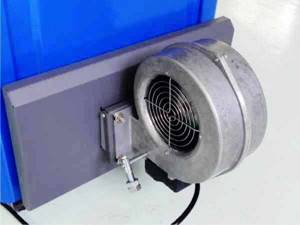
Therefore, it will be necessary to properly arrange the power part in order to put into operation such a device that is sensitive to current parameters.
The asynchronous electric motor makes it possible to easily adjust the speed. Certain modifications also have a reverse mode. The main positive qualities of fans with an asynchronous electric motor:
- simple and easy to use;
- have a durable design;
- traditional control scheme;
- used by a variety of control systems paired with a thermostat, for example, like the budget fan DP-02 from a Polish manufacturer.
Will the smoke exhauster burn out, what temperature can it withstand?
Smoke exhausters from other manufacturers operate at temperatures up to 200°C. They need to be cooled - placed outside. Since tar from flue gases condenses at temperatures below +80°C, in the cold season tar actively condenses on a cold impeller and soot adheres. The fouling of the impeller with dirt always ends with it jamming and the electric motor burning out.
The difference between smoke exhausters produced.
Our smoke exhauster can withstand higher flue gas temperatures.
We have developed and are producing smoke exhausters that can/should be installed immediately behind the boiler in a warm boiler room. As a result, the impeller is hot and dry all the time, nothing sticks to it. The temperature on the impeller reaches 150-400°C (much higher than the condensation temperature of the resin) - the resin and soot “evaporate”.
The usual temperature of flue gases is 150-250°C and the smoke exhauster must operate for a long time at these temperatures. The smoke exhauster operates stably at flue gas temperatures up to 350°C, and can withstand temperatures of more than 400°C for a short time, but such high temperatures can lead to the impeller steel burning out, i.e. corrode, become thinner and break down. To work in chemically aggressive environments and high temperatures, it is necessary to order smoke exhausters made of stainless steel.
Our smoke exhausters solve the problem of transferring and effectively removing heat from a hot impeller to the rotor shaft of an asynchronous electric motor. The impregnation of the motor winding does not dry out - the winding does not burn out.
ATTENTION: Monitor the temperature of the flue gases leaving the boiler!
Since our segment of the smoke exhaust market is low-power boilers, where there are many home-made boilers, we constantly remind homeowners of the need to install a thermometer on the chimney immediately after the boiler (before the smoke exhauster). Contamination of the heat exchanger means increased fuel consumption accompanied by an increase in the temperature of the flue gases at the boiler outlet. The impeller of a switched-off smoke exhauster may become severely overheated—it will become deformed.
Timely cleaning of the boiler means saving on fuel. Tired of cleaning your boiler often? Make a complete boiler piping - install a three-way valve and a bypass! Rapid contamination of the heat exchanger is facilitated by improper starting of the boiler and its prolonged operation with a “cold” coolant (condensation of resins on the walls of the heat exchanger)…
Can an electric motor burn out?
If it can burn, then why?
The smoke exhauster has an asynchronous motor, which can be connected to a 220 or 380 Volt network.
It is connected to a 380 V network by a star, and to a 220 V network through a capacitor of the appropriate rating (which depends on the engine power) by a specialist electrician. The connection to the 380 V network must comply with the requirements of the “Operation Manual for Asynchronous Motors”.
To prevent the electric motor from burning out during operation, it is necessary to install protection against overload and short circuit.
The settings of the protection devices must correspond to the operating mode of the electric motor, as well as its characteristics. Short circuit protection is carried out using fuses or circuit breakers (the second option is more preferable, as it eliminates the occurrence of a “phase loss” mode). When choosing a machine, it is necessary to take into account that the starting current of an asynchronous electric motor is 5–7 times higher than the rated one.
Thermal protection must be time-delayed and can be achieved using a thermal relay.
The use of “cheap” contactors for switching on, which are characterized by “sticking” of the contact in one of the phases, is the reason for the combustion of the electric motor during operation.
The operating instructions for asynchronous motors used on BAGAN smoke exhausters are posted in the documentation section at the link.
Specifications
The table below shows the technical characteristics of the VDN-10 blower fan. Total pressure (Pa), air capacity (m cubic hour), consumed electrical power (kW) are determined for fan operation with a fully open axial guide vane. The characteristic point passes through max efficiency (83%). Atmospheric pressure is assumed to be normal, temperature +30 °C, air density - 1.18 kg/m3.
VDN-10 is available with two types of engines with a power of eleven or thirty kW. For this reason, for fans with the same wheel diameter (with different engine power) the performance differs by 50% and the pressure by more than 100%.
The following table shows the characteristics of the VDN-10 fan.

RELIABILITY OF BAGAN SMOKE EXTRACTORS.
During the production of smoke exhausters, each impeller is balanced on a rotating electric motor rotor (about five minutes). This way we eliminate beats and resonances, and at the same time check the quality of the electric motors themselves.
We use only asynchronous motors with a long guaranteed service life (at least 10,000 hours) - they should last at least 2-3 years of operation. During operation during this period, only wear of the bearing or combustion of the winding is possible due to incorrect connection, without a protection device, or electrical power.
| HEAT-RESISTANT SMOKE EXTRACTORS “BAGAN” | |||
|
|
|
|
| Product Catalog | |||
What is the efficiency of a solid fuel boiler?The efficiency of a solid fuel boiler is often indicated as 90% or higher. It is difficult to obtain such a high efficiency, much less an official document confirming it. To do this, it is necessary to carry out special tests, since conventional fuel, in terms of its characteristics and composition, is very unstable... Read the article... |
Why do you need a three-way valve?
The main purpose of a three-way valve. In relation to a solid fuel boiler, its function is to maintain a high temperature of the boiler to reduce the condensation of resins on its inner surface. This ensures the required temperature of the coolant used for heating by mixing hot boiler water with low-temperature water supplied back from the consumer... Read the article... |
Which boiler is better?One that doesn't create problems for us. Which you can forget about and not remember, because... it heats without “dust and noise” and doesn’t even smoke. In which the coal itself pours from the hopper onto the grate and burns, without hanging up, becoming coked. Which will not go out, will not wake you up at four o'clock in the morning with the cold in the winter cold. A boiler whose grates do not burn out and which itself maintains the temperature. And it is important that the coal bunker is large at the boiler. So that it does not boil, the seams do not burst and water does not suddenly leak out. And the most important thing is that you don’t have to constantly clean it of tar and soot! Such a brief technical specification for the development of the boiler was formulated during its design... Read the article... |
Calculation of the required power of a hot water boiler.
A hot water boiler is installed not only to heat the coolant in the heating system, but also to supply hot water to housing. To determine the required boiler power, it is necessary to separately consider each of the connected systems (circuits): — radiator heating - warm floor - hot water for domestic needs Read the article... |
